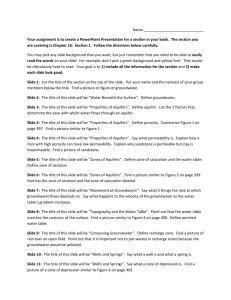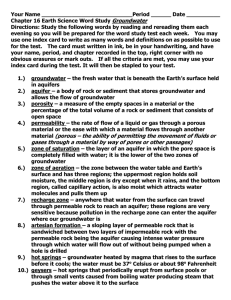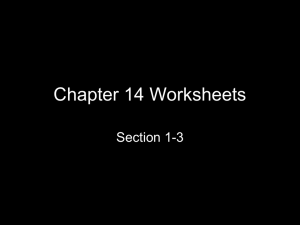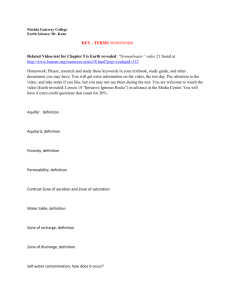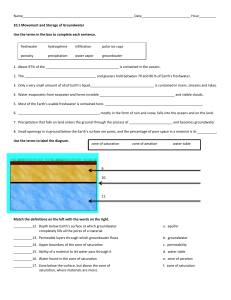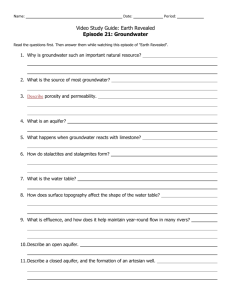Chapter 16 - Groundwater
advertisement
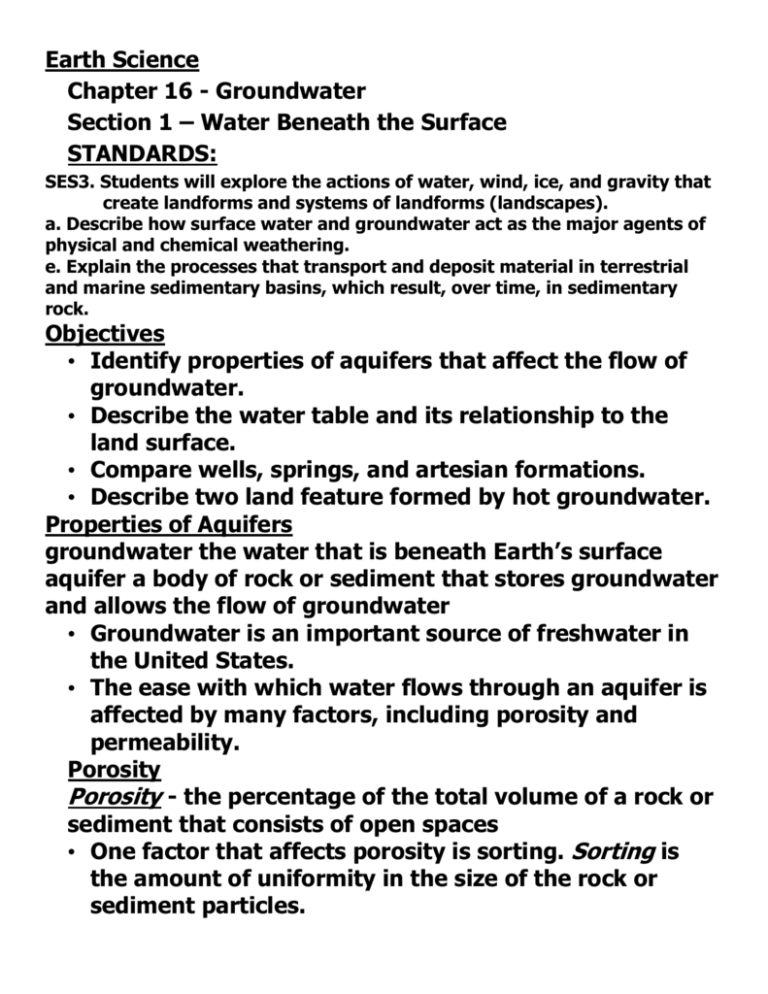
Earth Science Chapter 16 - Groundwater Section 1 – Water Beneath the Surface STANDARDS: SES3. Students will explore the actions of water, wind, ice, and gravity that create landforms and systems of landforms (landscapes). a. Describe how surface water and groundwater act as the major agents of physical and chemical weathering. e. Explain the processes that transport and deposit material in terrestrial and marine sedimentary basins, which result, over time, in sedimentary rock. Objectives • Identify properties of aquifers that affect the flow of groundwater. • Describe the water table and its relationship to the land surface. • Compare wells, springs, and artesian formations. • Describe two land feature formed by hot groundwater. Properties of Aquifers groundwater the water that is beneath Earth’s surface aquifer a body of rock or sediment that stores groundwater and allows the flow of groundwater • Groundwater is an important source of freshwater in the United States. • The ease with which water flows through an aquifer is affected by many factors, including porosity and permeability. Porosity Porosity - the percentage of the total volume of a rock or sediment that consists of open spaces • One factor that affects porosity is sorting. Sorting is the amount of uniformity in the size of the rock or sediment particles. • Particle packing also affects porosity. Grain shape also affects porosity. Permeability permeability - the ability of a rock or sediment to let fluids pass through its open spaces, or pores • For a rock to be permeable, the open spaces must be connected. • Permeability is also affected by the size and sorting of the particles that make up a rock or sediment. The larger and better sorted the particles are, the more permeable the rock or sediment tends to be. Zones of Aquifers • Gravity pulls water down through soil and rock layers until the water reaches impermeable rock. • Water then begins to fill, or saturate, the spaces in the rock above the impermeable layer. • As more water soaks into the ground, the water level rises underground and forms two distinct zones of groundwater. Zone of Saturation water table the upper surface of underground water; the upper boundary of the zone of saturation • The layer of an aquifer in which the pore space is completely filled with water is the zone of saturation. • The term saturated means “filled to capacity.” • The zone of saturation is the lower of the two zones of groundwater. Zone of Aeration • The zone that lies between the water table and Earth’s surface is called the zone of aeration. • The zone of aeration is composed of three regions. • Water is drawn up from the zone of saturation into the capillary fringe by capillary action. Capillary action is caused by the attraction of water molecules to other materials, such as soil. READING CHECK What are the two zones of groundwater? The two zones of groundwater are the zone of saturation and the zone of aeration. Movement of Groundwater • Water passes quickly through highly permeable rock and slowly through rock that is less permeable. • The rate at which groundwater flows horizontally depends on both the permeability of the aquifer and the gradient of the water table. • Gradient is the steepness of a slope. • The velocity of groundwater increases as the water table’s gradient increases. Topography and the Water Table • The depth of the water table below the ground surface depends on surface topography, the permeability of the aquifer, the amount of rainfall, and the rate at which humans use water. • Only one water table exists in most areas. • In some areas, however, a layer of impermeable rock lies above the main water table. Water collects on top of this upper layer and creates a second water table, which is called a perched water table. The image below shows the water table and a surface topography. READING CHECK What four factors affect the depth of a water table? The depth of a water table depends on topography, aquifer permeability, the amount of rainfall, and the rate at which humans use the groundwater. Conserving Groundwater • Although groundwater is renewable, its long renewal time limits its supply. Groundwater collects and moves slowly, and the water taken from aquifers may not be replenished for hundreds or thousands of years. • Communities often regulate the use of groundwater to help conserve this valuable resource. • Some communities recycle used water. This water is purified and may be used to replenish the groundwater supply. • Surface water enters an aquifer through an area called a recharge zone. • A recharge zone is anywhere that water from the surface can travel through permeable rock to reach an aquifer. • Recharge zones are environmentally sensitive areas because pollution in the recharge zone can enter the aquifer. Wells and Springs • Groundwater reaches Earth’s surface through wells and springs. • A well is a hole that is dug to below the level of the water table and through which groundwater is brought to Earth’s surface. • A spring is a natural flow of groundwater to Earth’s surface in places where the ground surface dips below the water table. Spring Wells and Dirt Baths ~ Bealtaine Cottage Ordinary Wells and Springs • Ordinary wells work only if they penetrate highly permeable sediment or rock below the water table. • If the rock is not permeable enough, groundwater cannot flow into the well quickly enough to replace the water that is withdrawn. • Pumping water from a well lowers the water table around the well and forms a cone of depression. • Ordinary springs are usually found in rugged terrain where the ground surface drops below the water table. • These springs may not flow continuously if the water table in the area has an irregular depth as a result of variable rainfall. Artesian Wells and Springs artesian formation a sloping layer of permeable rock sandwiched between two layers of impermeable rock and exposed at the surface • Water in some wells may come from as far away as hundreds of kilometers. • The permeable rock is the aquifer, and the top layer of impermeable rock is called the caprock. • Because the water is under pressure, when a well is drilled through the caprock, the water quickly flows up through the well and may even spout from the surface. • An artesian well is a well through which water flows freely without being pumped Artesian Well in Aiken, South Carolina • When cracks occur naturally in the caprock, water from the aquifer flows through the cracks. This flow forms artesian springs. Washington Oak State Gardens Artesian Springs READING CHECK What is the difference between ordinary springs and artesian springs? Ordinary springs occur where the ground surface drops below the water table. An artesian spring occurs where groundwater flows to the surface through natural cracks in the overlying caprock. Hot Springs • Groundwater is heated when it passes through rock that has been heated by magma. • Hot groundwater that is at least 37°C and that rises to the surface before cooling produces a hot spring. • When water in a hot spring cools, the water deposits minerals around the spring’s edges. • The deposits form steplike terraces of calcite called travertine. Hot springs in Yellowstone National Park in Wyoming. Geysers • Hot springs that periodically erupt from surface pools or through small vents are called geysers. • A geyser consists of a narrow vent that connects one or more underground chambers with the surface. • Release of the water near the top of the vent relieves the pressure on the superheated water farther down. • The eruption continues until most of the water and steam are emptied from the vent and chambers. Old Faithful in Yellowstone National Park in Wyoming.
